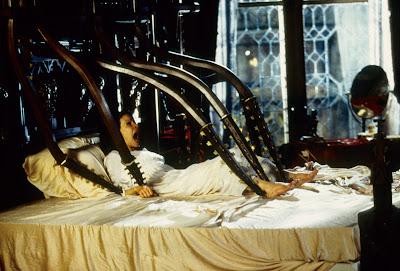Format: Streaming video from Amazon Prime on Fire!

From a creative perspective, I fully understand the desire for someone to want to remake a story that they like and know well. Over and over, though, great films are frequently remade badly. Consider, for instance how few American remakes of Japanese horror movies are actually worth watching. The Ring, surely, possibly The Grudge, and maybe a few others, but most of them are trash. There’s a reason that every now and then, a meme will surface about remaking terrible movies with good plots to give them another chance. Sadly, with the 1999 remake of The Haunting, we’re instead getting a shabby retelling of a classic story.
Unfortunately for this film, it’s competing against two masterpieces. The original filmed version of Shirley Jackson’s The Haunting of Hill House is an amazing horror film, terrifying in places and surprising because it is rated G. Today, this is also competing with the made-for-NetFlix miniseries that is arguably the best horror-themed short-form series ever made, and at least in the conversation. I’m not going to bury the lede—in comparison, this is a cheap knock-off.
Nell Vance (Lili Taylor) has cared for her ailing mother for just over a decade. When her mother dies, Nell’s sister Jane (Virginia Madsen) and Jane’s husband Lou (Tom Irwin) show up essentially to evict her from the apartment she has lived in caring for her and Jane’s mother. They offer her a job of caring for their rather obviously toxic child. Instead, Nell signs up for an insomnia study at a huge house in western Massachusetts. Importantly, it gives her a place to stay, at least temporarily, and pays $900/week.
Also participating in the study are the clearly wealthy and snobbish Theo (Catherine Zeta-Jones) and pushy, aggressive, and perhaps funny Luke (Owen Wilson). Leading the study is Dr. David Marrow (Liam Neeson), who is aided by his assistant Mary (Alix Koromzay). The house where all of this is going to take place is the huge, sprawling Hill House, tended by the caretakers, Mr. and Mrs. Dudley (Bruce Dern and Marian Seldes). And, of course, the giant house is alleged to be haunted, because Marrow is studying the nature of fear, not actually dealing with insomnia.
So, if you know anything about horror movies, you’re going to know going in that the house is actually going to be haunted, because otherwise, what’s the point. Nell, who has spent much of her life focused on her ailing mother, is going to prove to be the most susceptible to whatever is going on in the house, and while the others will spend a great deal of time assuming that Nell is trying to bring attention to herself, it’s soon going to be evident that there is something actually happening, and that Nell is the focus.
The original idea of The Haunting of Hill House is that the house in question was “born bad.” It was a cursed house, not something that was planned or created, but something that simply happened. People die at Hill House, go crazy, waste their lives, and commit suicide at times. But that’s not going to be enough for this version. We can’t simply have a “bad house” that is filled with paranormal experiences. No, for this version of the story, we need to have a villain who will be responsible for why the house is cursed. It turns out that the original builder, Hugh Crain, got rich from textile mills, and naturally used child labor—and specifically brought children to his home to kill them. And, naturally, Nell is not just attuned to the house, but an actual descendant of Crain’s second wife. So, now we have Nell trying to appease all of the ghosts of all of the dead children.
This is the main problem with this version of The Haunting. The original story works because it’s just a place that has gone bad and that exists in part to entice Nell to stay there, for it to be her “home.” The child-murdering builder, the relationship between Nell and his wife—none of this is necessary or true to the original story. It’s as if the screenwriter decided that the audience wouldn’t accept a story where such things simply happened; there had to be a big-bad for us to focus on.
It also suffers from pre-2000s CGI. The 1963 version of the story depended on atmosphere and suggestion. It’s scary because of what it implies in places, but it shows almost nothing. The miniseries is scary as hell because what it shows frequently looks real and the illusion is maintained. Here? What we’re seeing is the sort of sad phantasmagoria that you expect on a Disney ride. You can just about see the wires.
The source material for this is so good, as evidenced by the 1963 film and the miniseries. Why do filmmakers think they need to add things to something that is already telling a complete story? Nothing that is added to this actually adds anything, and that’s depressing.
Why to watch The Haunting (1999): It’s based on a classic story.
Why not to watch: The original is better, and so is the mini-series, and not by a little.
